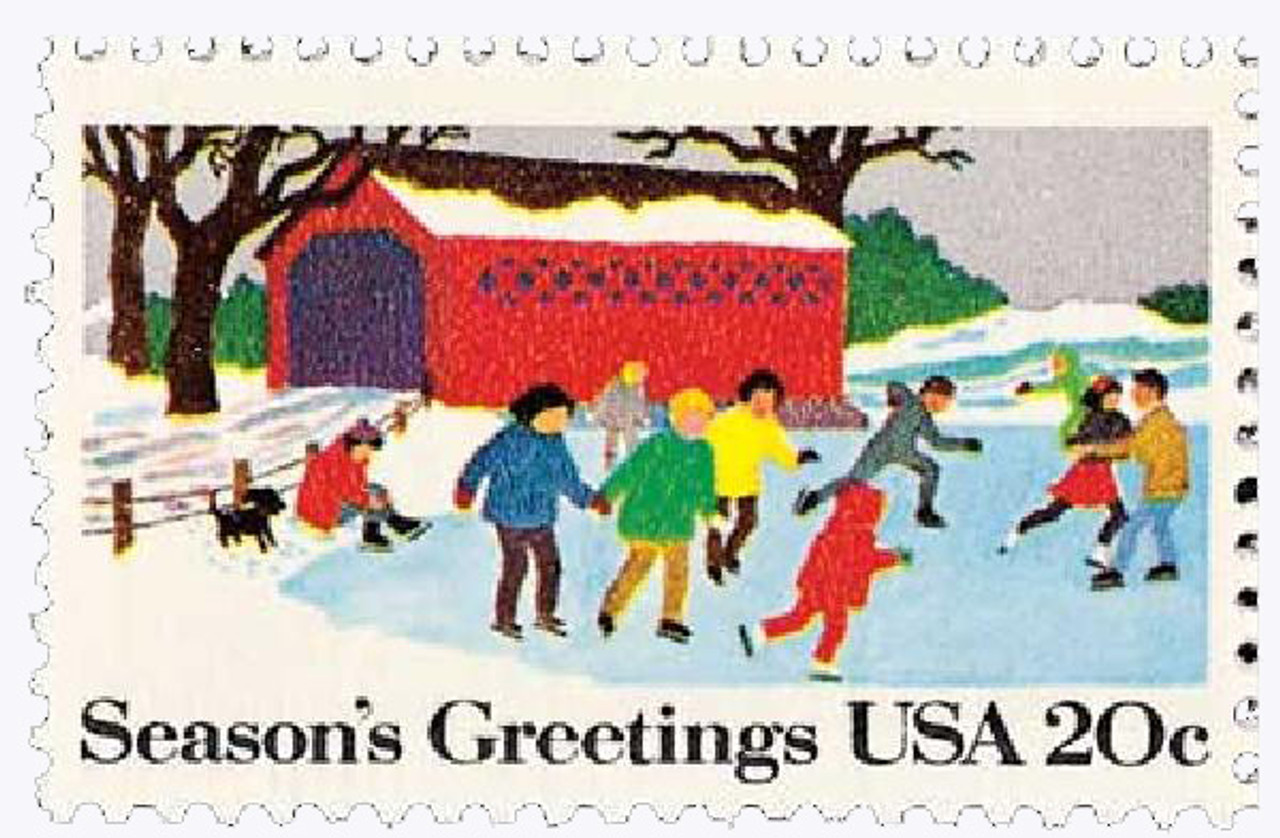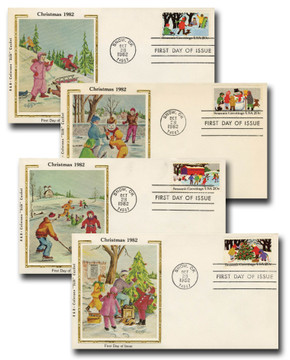
U.S. #2029
1982 20¢ Ice Skating
Season's Greetings
Contemporary Christmas
- From the 18th Contemporary Christmas issue
- One of four stamps depicting children enjoying fun winter activities
Stamp Category: Commemorative
Set: Season’s Greetings
Series: Contemporary Christmas
Value: 20¢, first-class rate
Fir... more
U.S. #2029
1982 20¢ Ice Skating
Season's Greetings
Contemporary Christmas
- From the 18th Contemporary Christmas issue
- One of four stamps depicting children enjoying fun winter activities
Stamp Category: Commemorative
Set: Season’s Greetings
Series: Contemporary Christmas
Value: 20¢, first-class rate
First Day of Issue: October 28, 1982
First Day City: Snow, Oklahoma
Quantity Issued: 197,220,000
Printed by: Bureau of Engraving & Printing
Printing Method: Photogravure
Format: Panes of 50 in sheets of 200
Perforations: 11
Why the stamp was issued: For use on winter and holiday mail.
About the stamp design: The 1982 Seasons Greetings stamps express the popular theme that Christmas is a time for children. Designed by Dolli Tingle, the Ice-Skating stamp pictures a group of people ice skating on a pond in front of a red covered bridge.
First Day City: The First Day ceremony for the Season’s Greetings stamps was held at the Recreation Center in Snow, Oklahoma.
Unusual fact about this stamp: Imperforate error stamps have been found.
About the Contemporary Christmas series: The US issued its first Christmas stamp (picturing a wreath and candles) on November 1, 1962, and it was wildly popular. The Post Office printed 350 million stamps, the largest print run for a special stamp up to that time, but still the stamps quickly sold out. The Bureau of Engraving and Printing produced more to satisfy demand and the total number issued was over 860 million by the end of the year.
In 1966, the Post Office started issuing traditional themed Christmas stamps picturing the Madonna and Child and other religious icons. In 1969, they switched back to non-religious Christmas designs with a stamp picturing the painting Winter Sunday in Norway, Maine.
Finally, in 1970, the Post Office decided to permanently split Christmas stamps into two categories to satisfy everyone: Traditional and Contemporary. They issued a block of four stamps picturing Christmas toys along with a stamp picturing a classic painting of the Nativity. The decision to do both proved popular, and the Post Office has continued to issue stamps in both categories ever since.
History the stamp represents: On bitter winter days, a layer of thick, smooth ice covers the lakes and ponds that just months earlier offered a refreshing swim. For thousands of years, people have enjoyed skating on iced-over swimming holes in the wintertime.
Historians believe that the earliest ice skating was done over 5,000 years ago. Flattened, sharpened bones were strapped to the bottom of the feet allowing the wearer to glide over the ice. It would be centuries before steel edges would be added.
Figure skating began to develop in the late 1700s. Robert Jones’ guide, A Treatise on Skating, established formal and rigid techniques for tracing patterns in the ice that would dominate the style for many years. Then, in the mid-1800s, American dancer Jackson Haines added ballet and music to his figure skating, forever transforming the sport.
Haines’ style was not well received in the United States, but he quickly became a celebrity overseas. He traveled Europe performing to widespread acclaim. He invented the sit spin, the toe-pick, and a short, curved blade to make spins easier.
The man who revolutionized the winter pastime into one of the most popular winter sports in the world, Jackson Haines will forever be known as the father of figure skating.







